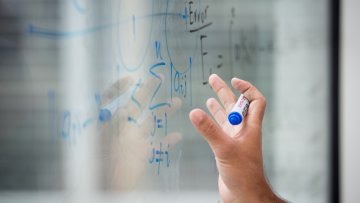Regularity for double phase variational integrals
Abstract
Those mentioned in the title are integral functionals of the Calculus of Variations characterized by the fact of having an integrand switching between two different kinds of degeneracies, dictated by a modulating coefficient. They have introduced by Zhikov in the context of Homogenization and to give new examples of the related Lavrentiev phenomenon. In this talk I will present some recent results aimed at drawing a complete regularity theory for minima.
So what should you do if the dead should begin to rise? Dr Thomas Woolley talks to the BBC about avoidance strategies based on mathematical modelling, strategies that can be applied to understanding how infections such as swine flu, HIV and Ebola spread, not least because of the role of media reporting. The item is 3 hours and 17 minutes in to the programme.
Our Mathematical Sciences submission to the 2014 Research Excellence Framework, covering research from the Mathematical Institute and the Department of Statistics, has been ranked overall best in the UK. The outcomes, released today, gave Oxford Mathematical Sciences the top ranking for research publications and for the impact of our research outside academia, and the equal top ranking for our research environment.
Networks and Criminality (see abstract for more details)
Abstract
The Network and Criminality Workshop will explore the capacity of mathematics and computation to extract insight on network structures relevant to crime, riots, terrorism, etc. It will include presentations on current work (both application-oriented and on methods that can be applied in the future) and active discussion on how to address existing challenges.
Invited speakers (in alphabetical order) are as follows:
Prof. Alex Arenas, Professor of Computer Science & Mathematics, URV, http://deim.urv.cat/~alexandre.arenas/
Prof. Henri Berestycki, Professor of Mathematics, EHESS, http://en.wikipedia.org/wiki/Henri_Berestycki
Prof. Andrea Bertozzi, Professor of Mathematics, UCLA, http://www.math.ucla.edu/~bertozzi/
Dr. Paolo Campana, Research Fellow, Oxford, http://www.sociology.ox.ac.uk/academic-staff/paolo-campana.html
Toby Davies, Graduate Student, UCL, http://www.bartlett.ucl.ac.uk/casa/people/mphil-phd-students/Toby_Davies
Dr. Hannah Fry, Lecturer in the mathematics of cities, UCL, https://iris.ucl.ac.uk/iris/browse/profile?upi=HMFRY30
Dr. Yves van Gennip, Lecturer in Mathematics, Nottingham, http://www.nottingham.ac.uk/mathematics/people/y.vangennip
Prof. Sandra González-Bailón, Assistant Professor at UPenn, http://dimenet.asc.upenn.edu/people/sgonzalezbailon/
Prof. Federico Varese, Professor of Criminology, Oxford, http://www.law.ox.ac.uk/profile/federico.vareserecep
If you are interested in attending this workshop, please register by following this link: https://www.maths.ox.ac.uk/node/13764/.
Electron correlation in van der Waals interactions
Abstract
14:15
Automorphism and isometry groups of Higgs bundle moduli spaces
Abstract
The moduli space of Higgs bundles on a hyperbolic Riemann surface is a complex analytic variety which has a hyperkahler metric on its smooth locus. As such it has several associated symmetry groups including the group of complex analytic automorphisms and the group of isometries. I will discuss the classification of these and some other related groups.
The evolution of the universe recreated in a supercomputer
Abstract
In this talk we will describe the steps towards self-consistent computer simulations of the evolution of the universe beginning soon after the Big Bang and ending with the formation of realistic stellar systems like the Milky Way. This is a multi-scale problem of vast proportions. The first step has been the Millennium Simulation, one of the largest and most successful numerical simulations of the Universe ever carried out. Now we are in the midst of the next step, where this is carried to a much higher level of physical fidelity on the latest supercomputing platforms. This talk will be illustrate how the role of mathematics is essential in this endeavor. Also computer simulations will be shown. This is joint work among others with Volker Springel.
Distinct solutions of nonlinear systems via deflation
Abstract
Nonlinear systems of partial differential equations (PDEs) may permit several distinct solutions. The typical current approach to finding distinct solutions is to start Newton's method with many different initial guesses, hoping to find starting points that lie in different basins of attraction. In this talk, we present an infinite-dimensional deflation algorithm for systematically modifying the residual of a nonlinear PDE problem to eliminate known solutions from consideration. This enables the Newton--Kantorovitch iteration to converge to several different solutions, even starting from the same initial guess. The deflated Jacobian is dense, but an efficient preconditioning strategy is devised, and the number of Krylov iterations is observed not to grow as solutions are deflated. The technique is then applied to computing distinct solutions of nonlinear PDEs, tracing bifurcation diagrams, and to computing multiple local minima of PDE-constrained optimisation problems.



